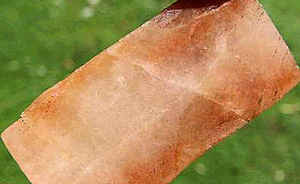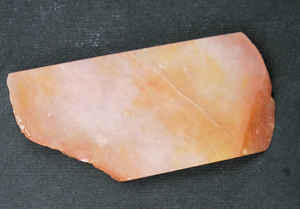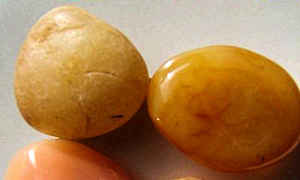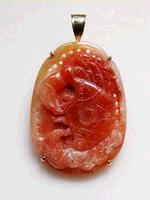Maryland State Gemstone or Gem
Patuxent River Stone (Agate)
SiO2 - Silicon Dioxide
Adopted on October 1, 2004.
Effective October 1, 2004, the Patuxent River Stone became the State Gem of Maryland (Chapter 272, Acts of 2004; Code State Government Article, sec. 13-319).
Maryland designated the Patuxent River stone as its official state gem. Proponents have suggested that the Patuxent River stone is agatized dinosaur bone. Others, however, believe that it is neither agate or dinosaur bone and that it is common quartzite.
Patuxent River Stone is actually an agate, a cryptocrystalline form of quartz. Found only in Maryland, the Patuxent River Stone's colors of red and yellow reflect the Maryland State Flag.
In 2004, Governor Bob Ehrlich signed legislation naming the Patuxent River Stone as Maryland's official state gem. The stone, named for the Chesapeake Bay tributary in which it appears, is a form of quartz found only in Maryland, according to the Maryland State Archives. Appropriately, iron gives the stone a red and yellow hue, the same colors as Maryland's state flag. The stone has been a subject of controversy among gem and mineral enthusiasts, however, thanks to the state's description of it as an agate, a specific form of quartz. Baltimore Mineral Society program director Jake Slagle says agates generally are not found in Maryland.
Patuxent River Stone (Agate):
Maryland State Gemstone or Gem
 Patuxent River stone is a local variety of
agate, found only in Maryland. Agate is a layered, multicolored variety of chalcedony. Chalcedony is a catchall term that includes quartz gemstones
with microscopic crystal structure. Agate is composed of silicon and oxygen, with iron and aluminum oxides sometimes present.
Patuxent River stone is a local variety of
agate, found only in Maryland. Agate is a layered, multicolored variety of chalcedony. Chalcedony is a catchall term that includes quartz gemstones
with microscopic crystal structure. Agate is composed of silicon and oxygen, with iron and aluminum oxides sometimes present.
Patuxent River stone may be a case of agate forming through fossilization of organic material, but this origin for the stone is disputed. Agate
most commonly forms in rounded nodules or veins. Often, centuries of water have washed the outer surface away to reveal the pattern inside. When this
is not the case, the crust must be cut open to view the stone's inner beauty. Tiny quartz crystals called drusy often form inside the stone, especially
in agates with hollow cavities. Since unpolished specimens of agate are dull, they are polished to bring out their full beauty.
Agate has hundreds of variety names, and new ones are introduced every year. Some of the more common varieties are fire, blue, blue lace, banded, carnelian,
Lake Superior, thunder egg, and turritella agates. Patuxent River stone, or Patuxent River agate, is said to be composed of fragments of petrified
bone that were filled in with silica and clay over 100 million years ago. Recently found specimens reportedly show a link to dinosaur bones.

The gem is occasionally found in the late Cretaceous gravel of the Arundel formation, which has been mined for decades for construction material. It is silica replaced fragments of petrified bone material, mostly dinosaur bone, and is evidence of Maryland's roughly 115 million year old bay type environment. Perhaps 10,000 generations of dinosaurs are represented in the exposed Arundel formation which outcrops though the middle of the state. The petrification process amounted to infilling of bone marrow by silica and minute amounts of clay. Perhaps, there may have been some later changes in the crystal structure due to depth of burial. Recently found specimens prove that there is a link to dinosaur bones. Many of the internal bone patterns can be readily seen in the cut stones and slabs. The history of this stone itself is an asset as a gemstone. The gems can be found best in a narrow band running from Washington D.C. northeast through Baltimore and, thanks to movement by the glaciers, the gems also exist in younger sediments throughout the Eastern shore area. The nature of the formation of these stones may also be connected with the Geothermal hot spots that still exist on the Eastern shore. We have a number of fine gem, mineral, and Lapidary clubs in Maryland. It will also be an asset for school study and may touch citizenry at large that are interested in something native to Maryland. What could be more appropriate for the Bay state than to have a state gem formed on these very lands 115 million years ago when Maryland was also a swampy bay?
BIRTHSTONE

Agate is the mystical birthstone for September and the birthstone for the zodiac sign of Gemini. Agate is given for the 12th and 14th wedding anniversaries.
The word Agate comes from the Greek name for a stone originally found in the Achates River in Sicily (currently known as Drillo River). Agate has been found with the remains of Stone Age man in France from as early as 20,000-16,000 B.C. and the Egyptians used agates prior to 3000 B.C. for talismans, amulets, seals, rings and vessels. Early civilizations used eye beads to protect them from evil and bring good luck. They created eye beads by carving a hole through an agate disc.
Ancient civilizations believed that wearing agate would make them invisible, thus protecting them from danger. Farmers used agates to ensure good crops. Romans wore agate to please the gods that would bring an abundant harvest. In Persia, agate was worn to confer eloquence and magicians used the crystal to divert dangerous storms. In ancient Asia, agates were used to see the future. Early Britons used the gem to prevent skin disease. Agate talismans were worn in the Middle East to keep the blood healthy. Sucking on an agate was thought to relieve thirst. Another legend says that any person who looks upon an agate can not remain secretive and is obligated to tell the truth.
Agate is said to have mystical powers to guard one against danger, to cure insomnia, to ensure pleasant dreams and to help with clarity enabling one to see the world through a broader perspective. It attracts good fortune, increases concentration and promotes good will. Agate is reported to be an aid in overcoming flaws, fears, and loneliness. It is believed to remove curses and spells and helps to eliminate bad luck. Many believe that agate has a calming effect during times of stress and that it gives a sense of strength and courage. It is thought to stimulate fertility and to be advantageous in relieving bone marrow ailments and allergies. Artists and writers have used agate to enhance creativity.
For centuries agate was known as a powerful healer, a bringer of good fortune and wealth. Hindu mystics believe that agate helps children overcome fears.
Maryland Law
The law designating the Patuxent River stone (agate) as the official Maryland state gem is found in the Maryland Statutes, Title 13, Section 13-304
STATE GOVERNMMENT
TITLE 13. EMBLEMS; COMMEMORATIVE DAYS; MANUAL.
SUBTITLE 3. ADDITIONAL EMBLEMS; DESIGNATIONS
SECTION 13-304.
§-319.
The Patuxent River stone is the State gem.
Minerals, & Gems

Gemstone, Minerals, Rocks







